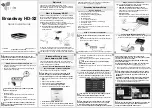
7
Circuit Description
The VX-3R/E consists of a MAIN-UNIT, a FILTER-UNIT,
a SW-UNIT, and a VCO-UNIT. The MAIN-UNIT contains
the receiver front end, PLL IC, power and switching cir-
cuits, the CPU, audio ICs, and the power circuitry for the
LCD, the IF, and audio ICs and the VCO-UNIT for trans-
mit and receive local signal oscillation.
Receiver Signal Flow
The VX-3R includes four receiver front ends, each opti-
mized for a particular frequency range and mode combi-
nation.
(1) Triplexer
Received 145 MHz signals, after passing through a low-
pass filter to the VHF T/R switch circuit composed of di-
ode switch
D1052
(
RLS135
) and
D1053
(
1SV307
).
Received 430 MHz signals, after passing through a low-
pass filter to the UHF T/R switch circuit composed of di-
ode switch
D1050
(
RLS135
) and
D1051
(
1SV307
).
(2) VHF Bands Reception
Received signals between 140 and 150 MHz pass through
the Triplexer circuit, low-pass filter/high-pass filter cir-
cuit, VHF T/R switch circuit and protector diode
D1003
(
1SS362
) before additional filtering by a band-pass filter
prior to application to RF amplifier
Q1003
(
2SC5555
). The
amplified RF signal is pass through the band-pass filter
to first mixer
Q1020
(
2SC5555
). Meanwhile, VHF output
from the VCO-UNIT is amplified by
Q1048
(
2SC5374
)
and applied through diode T/R switch
D1038
(
DAM222M
)
to mixer
Q1020
(
2SC5555
) as the first local signal.
The 47.25 MHz intermediate frequency product of the
mixer is delivered to the IF circuit.
The TUNE voltage from the CPU is amplified by DC am-
plifier
Q1025
(
NJU7007F3
) and applied to varactors
D1011
(
1SV325
),
D1012
(
1SV325
),
D1013
(
HVC369B
),
D1014
(
1SV325
),
D1015
(
1SV325
),
D1016
(
HVC369B
),
D1025
(
1SV325
), and
D1026
(
1SV325
) in the variable fre-
quency band-pass filters. By changing the electrostatic ca-
pacitance of the varactors, optimum filter characteristics
are provided for each specific operating frequency.
(3) UHF Bands Reception
Received signals between 430 and 450 MHz pass through
the Triplexer circuit, low-pass filter/high-pass filter cir-
cuit, UHF T/R switch circuit and protector diode
D1002
(
1SS326
) before additional filtering by a band-pass filter
prior to application to RF amplifier
Q1002
(
2SC5555
). The
amplified RF signal is pass through the band-pass filter,
RF amplifier
Q1013
(
2SC5555
) and band-pass filter to first
mixer
Q1019
(
2SC5555
). Meanwhile, UHF output from
the VCO-UNIT is amplified by
Q1056
(
2SC5374
) and ap-
plied through diode T/R switch
D1039
(
DAM222M
) to
mixer
Q1019
(
2SC5555
) as the first local signal.
The 47.25 MHz intermediate frequency product of the
mixer is delivered to the IF circuit.
The TUNE voltage from the CPU is amplified by DC am-
plifier
Q1025
(
NJU7007F3
) and applied to varactors
D1005
,
D1010
,
D1023
, and
D1024
(all
HVC358B
) in the
variable frequency band-pass filters. By changing the elec-
trostatic capacitance of the varactors, optimum filter char-
acteristics are provided for each specific operating fre-
quency.
(4) 47.25-MHz First Intermediate Frequency
The 47.25 MHz first intermediate frequency from first
mixers is delivered from the first mixer to IF circuit. On
the MAIN-UNIT, the IF for AM and FM-narrow signals
is passed through diode switch
D1030
(
DAP222M
) and
47.25 MHz monolithic crystal filter (MCF) XF1001 to nar-
row IF amplifier
Q1030
(
2SC4915
) for input to IF IC
Q1047
(
NJM2552V
) after amplitude limiting by
D1033
(
DA221M
).
Meanwhile, a portion of the output of 11.7 MHz crystal
X1001 is multiplied fourfold by
Q1035
and
Q1037
(both
2SC4915
) to provide the 46.8 MHz second local signal,
applied to the Narrow IF IC. Within the IC, this signal is
mixed with the 47.25 MHz first intermediate frequency
signal to produce the 450 kHz second intermediate fre-
quency.
This second IF is filtered by ceramic filter CF1002 and
amplified by the limiting amplifier within the Narrow IF
IC before quadrate detection by ceramic discriminator
CD1001.
Demodulated audio is output from pin 11 of the Narrow
IF IC through narrow mute analog switch
Q1068
(
2SJ364
).
The resulting audio is amplified by AF amplifier
Q1005
(
NJM2151AV
), and output through MIC/EAR jack J1004
to internal speaker SP1001 or an external earphone.
Transmitter Signal Flow
(1) 145 MHz Band Transmit/Receive Switching
Closing PTT switch S3003 on the SW-UNIT pulls the base
of
Q1011
(
DTA144EM
) low, causing the collector to go
high. This signal is input to pin 44 (PTT) of CPU
Q1095
(
HD64F2266TF13V
), allowing the CPU to recognize that
the PTT switch has been pushed. When the CPU detects
closure of the PTT switch, pin 70 (TX/RX) goes high. This
control signal switches
Q1069
(
RN4985
) to produce the
TX control signal that activates
Q1071
(
2SA2029
). At the
same time, PLL division data is input to PLL IC
Q1041
(
MB15A01PFV1
) from the CPU, to disable the receiver
power saver. Also, switching
Q1070
(
EMG2
) to disable
the receiver circuits. Then causing the red side of BUSY/
TX lamp
D1009
(
CL-165HR/YG
) to light.
Summary of Contents for VX-3R
Page 5: ...5 Block Diagram...
Page 6: ...6 Note...
Page 15: ...15 Circuit Diagram MAIN Unit Lot 1 3...
Page 16: ...16 Note MAIN Unit Lot 1 3...
Page 19: ...19 MAIN Unit Lot 4 Circuit Diagram...
Page 20: ...20 MAIN Unit Lot 4 Note...
Page 36: ...36 Note Main Unit...
Page 37: ...37 Filter Unit Circuit Diagram...
Page 40: ...40 Filter Unit Note...
Page 41: ...41 SW Unit Lot 1 3 Circuit Diagram...
Page 43: ...43 SW Unit Lot 4 Circuit Diagram...
Page 47: ...47 VCO Unit Circuit Diagram...
Page 51: ...51...








































